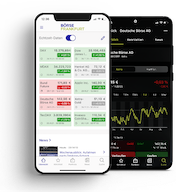Market sentiment: "Collect the chips first"

Last week's bulls only gave the DAX a brief interlude
Zusammenfassung
It was primarily institutional investors who, with the active help of US President Donald Trump and his sudden turnaround on customs policy, were rewarded for their courage with considerable gains in the DAX. However, this recovery does not seem to have been trusted, which is why profits were often taken quickly - since then, it has been better to wait and see. Private investors, on the other hand, have not been dissuaded from their optimistic stance. According to Joachim Goldberg, it is quite possible that many are looking beyond a medium-term trading horizon.
16 April 2025. FRANKFURT (Goldberg & Goldberg). Shortly before the publication of the future US tariff increases last week, we mused here about how difficult it was to estimate the extent of this far-reaching measure. By late evening last Wednesday, it was clear that the figures that US President Trump had proudly held up on his blackboard had probably exceeded even the worst fears. As a result, stock markets around the world suffered massive price falls, with the DAX also losing around 17% of its value at times. Memories of the outbreak of the coronavirus pandemic were evoked and comparisons with the 2008 financial crisis, the bursting of the dotcom bubble in 2000 and the 1987 stock market crash were drawn in many places.
But that's not all: share prices became massively volatile, as evidenced by the brief recovery of over 10% last Monday, for example, when the news that Donald Trump might grant a 90-day reprieve to the countries hit by the new tariffs quickly spread, giving investors new hope. However, this news soon turned out to be false. And just as quickly, share prices plummeted again. Today, one week later, the DAX is down 10.8% compared to last Wednesday.
A hearty bite
At the end of last week, stock market participants elsewhere were still very pessimistic, but in the meantime, institutional investors with a medium-term trading horizon surveyed by us have become quite clearly optimistic. This is because our Börse Frankfurt Sentiment Index has risen by 25 points compared to the previous week to a new level of +15. Incidentally, this is the highest level of optimism since 20 November 2024, with the increase of 17 percentage points among bulls consisting almost equally of previously neutral and recently pessimistic investors who have turned their position 180 degrees from bearish to bullish. Naturally, the high volatility makes it difficult to assess the levels at which these investments were made. In any case, a fairly large proportion of investors seem to be of the opinion that “enough is enough”.
The main question circulating among private investors recently was: “Can I get back in now?” And over the past few days, a fairly decent figure has apparently answered this question with a yes. At least, the Börse Frankfurt Sentiment Index of private investors has risen by 12 points to a new level of +18. As usual, it was primarily the investors surveyed via social media who swung to the bull side, while the others only moved their positions slightly. Incidentally, four-fifths of the 10 percentage point increase in the bull camp came from previously neutral investors. The latter now only account for 10% of respondents, the lowest figure since April 2020. In addition, the sentiment gap between the two subgroups within private investors has now widened again.
Faithless bulls
The bottom line is that private investors and institutional investors are not so far apart in terms of sentiment, although not only long-term dip buyers are likely to have been on the move, but of course also bargain hunters. The latter, whom we expect to be among the institutional investors in particular, are naturally unlikely to remain loyal to the DAX for too long, especially if the hoped-for gains do not materialize quickly enough. In this respect, they represent a burden for the DAX. On the one hand, if the current long positions were to reappear on the upside as part of profit-taking. Or on the other hand, if the most recent long positions have to be liquidated at a loss in the course of a renewed wave of selling on the DAX, which would lend additional momentum to a sell-off. Overall, therefore, the all-clear cannot be given for the DAX.
by Joachim Goldberg
16 April 2025, © Goldberg & Goldberg für boerse-frankfurt.de
Videokommentar
Sentiment-Index institutioneller Anleger*innen

| Bullish | Bearish | Neutral | |
| Total | 30% | 41% | 29% |
| ggü. letzter Erhebung | -21% | +5% | +16% |
DAX (change from previous survey): 21,000 points (+1,100 points compared to the previous survey)
Börse Frankfurt Sentiment Index institutional investors: -11 points (-26 points compared to previous survey)
Sentiment-Index privater Anleger*innen

| Bullish | Bearish | Neutral | |
| Total | 50% | 30% | 20% |
| ggü. letzter Erhebung | -4% | -6% | +10% |
DAX (change from previous survey): 21,000 points (+1,100 points compared to the previous survey)
Börse Frankfurt Sentiment Index institutional investors: +20 points ( +2 points compared to previous survey)
Über den Börse Frankfurt Sentiment-Index
Der Börse Frankfurt Sentiment-Index bewegt sich zwischen -100 (totaler Pessimismus) und +100 (totaler Optimismus), der Übergang von positive in negative Werte markiert die neutrale Linie.
Weitere Artikel dieses Kolumnisten
| Uhrzeit | Titel |
|---|






